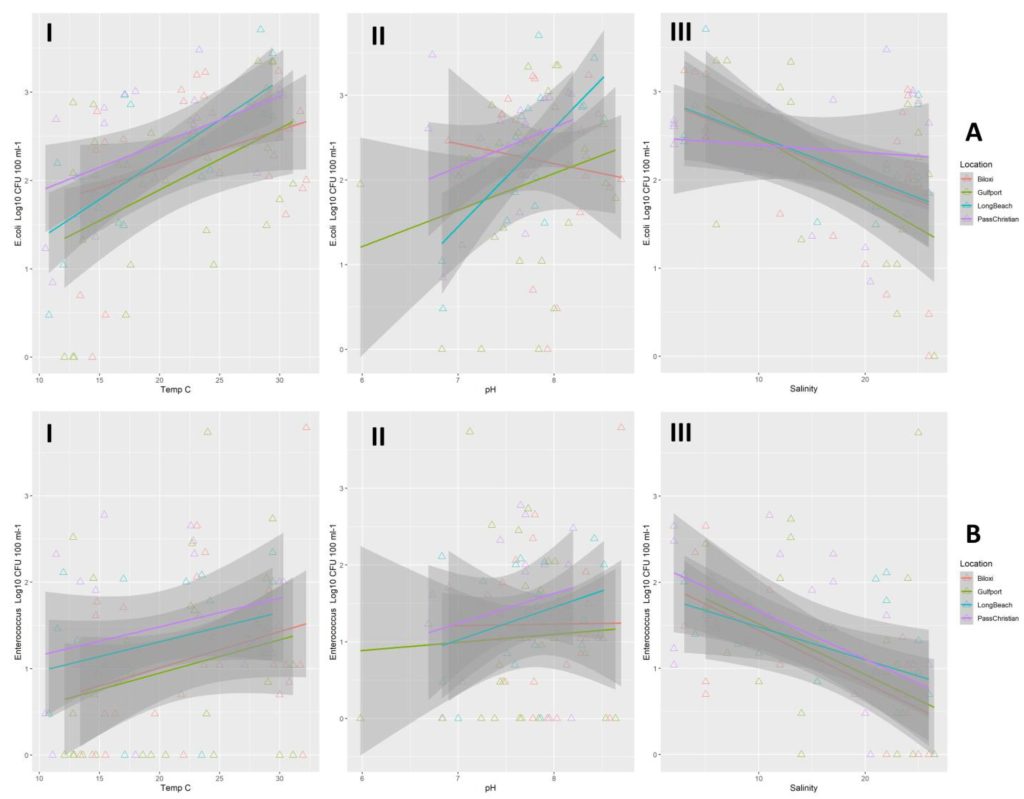Correlations observed between tested physical parameters (I. temperature, II. pH, and III. salinity) and microbial FIB contamination measurements within sampled sites. (A). E. coli and (B). Enterococcus. Credit: Water (2023). DOI: 10.3390/w15132339
A University of Southern Mississippi (USM) graduate and one of her former professors have collaborated on a project they hope will change the way researchers look at contamination along the Mississippi Gulf Coast.
Dr. Maitreyee Mukherjee, an assistant professor of biology at West Texas A & M and former faculty member at USM, had this research published in the journal Water along with her former students, USM alumna Robyn Cuthbert, Kristi Gay, Emma Aitken, and Katonia McKinney detailing how they found high levels of microbial fecal contamination and concerning levels of resistance within these bacteria to various antibiotics.
Dr. Mukherjee saw there was a need for research opportunities for her students along the Gulf Coast, inspiring the creation of the project to examine how contamination ranges within these 10 sites across different beaches between Bay Saint Louis and Biloxi.
“This research was planned here considering how many people are using our beaches for swimming, boating and fishing,” said Dr. Mukherjee, who has expertise in environmental microbiology, particularly in water quality and contamination.
The project focused on analyzing the levels of microbial pathogenic contamination and antimicrobial resistance/ multidrug resistance patterns within the bacteria found in the MS Gulf Coast.
“People should be paying attention to this study because our data reveals high levels of microbial contamination within these sites,” said Mukherjee.
Cuthbert, one of the student research leads and a former USM biology undergraduate, said USM students were heavily involved with the work from the start of the research in 2020 to its completion in 2023. She was a student assistant working with Dr. Mukherjee at USM, who approached Cuthbert about working on this research study.
The project involved student researchers going to the selected ten beach sites early in the day to collect water samples once a month between 2020-2021. Each month, following collection, they would return to the lab with the samples and then process the samples to analyze the levels of contamination present within the water. The students followed standard EPA methods dedicated for measuring microbial contamination in recreational waters. In addition, the students also looked at the levels of antimicrobial resistance and multidrug resistant ‘superbugs’ present in these waters.
“I thought it was fascinating to focus on extent of bacterial contamination along the Mississippi Gulf Coast, especially since I see people at the beaches every day,” Cuthbert said. “There’s still a lot of research to be done, and we have future directions we want to take for this project, e.g., studying the sources of the contaminants we found in the waters here.”
How are these contaminants entering the Gulf Coast waters in the first place? Dr. Jennifer Walker, Associate Dean of the College of Arts and Sciences and Associate professor in the USM School of Coastal Resilience, said with any type of pollution, one might think of a place that can be pointed to as the source, but research isn’t always able to identify specifically where these contaminants originate.
“A lot of these bacteria come from natural runoff,” Dr. Walker explained. “It’s hard because you can’t capture and clean all of the water from runoff.”
With the help of her expertise in microbial source tracking (MST), Dr. Mukherjee wants to address some of these questions regarding identifying some of these sources and to find out whether the contamination is human or animal related.
“This is not just environmental data, this study also reveals how much of these drug-resistant bacteria are present in the water that can potentially lead to high infections in individuals,” said Dr. Mukherjee.
More information: Maitreyee Mukherjee et al, Revealing an Abundance of Microbial Fecal Contamination and Multidrug Resistant Bacteria in the Mississippi Gulf Coast, Water (2023). DOI: 10.3390/w15132339
Provided by University of Southern Mississippi
Citation: New research examines contamination in gulf coast waters (2023, July 20) retrieved 31 July 2023 from https://phys.org/news/2023-07-contamination-gulf-coast.html
This document is subject to copyright. Apart from any fair dealing for the purpose of private study or research, no part may be reproduced without the written permission. The content is provided for information purposes only.

